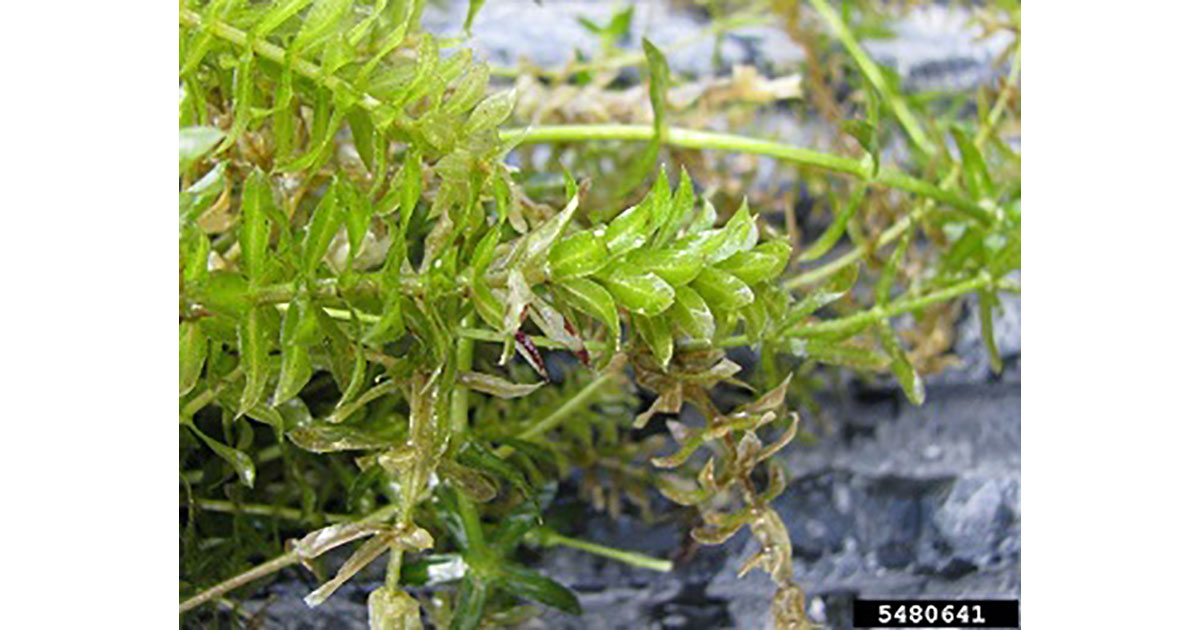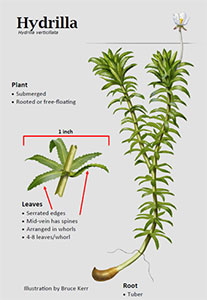MDNR Report
 Invasive Hydrilla
Invasive Hydrilla
Hydrilla, considered one of the world's most invasive aquatic plants, has been detected for the first time in Michigan. The Department of Environment, Great Lakes and Energy confirmed two small populations of the plant in adjacent private ponds on residential properties in Berrien Springs in Southwest Michigan during the summer.
The small patches of hydrilla (Hydrilla verticillata) were discovered during routine monitoring following treatment for another invasive plant, parrot feather, which was found in the pond in 2020. Both species are prohibited in Michigan, meaning it is unlawful to sell, possess or import them into the state, and both are on Michigan’s invasive species watch list due to their potential environmental threat.
Hydrilla has several ways of reproducing, allowing it to spread rapidly, outcompete native plants and quickly form dense single-species infestations. Root tubers, turions (buds) and even small plant fragments can develop into new plants, making it very easy for hydrilla to disperse through water or attach to ornamental plants sold for water gardens.
“It’s not clear how either plant made its way to this pond, but seeds or fragments of the invasive plants may have been attached to ornamental plants installed in past years,” said Bill Keiper, EGLE aquatic biologist. “Sediment core samples of the pond and genetic analysis of the plant material are planned to help determine how long the hydrilla has been here and where in the U.S. it might have originated.”
EGLE’s immediate response actions include surveying connected ponds, a receiving stream, and the St. Joseph River to ensure the full hydrilla population extent is known. Herbicide treatments are underway in the infested ponds, targeting hydrilla plants to prevent further tuber production this season. A response plan will focus on preventing the spread of hydrilla beyond its current location, with the long-term goal of eradication.
Why be concerned?
Hydrilla was introduced into Florida in the 1950s and has spread across the southeast. A separate strain was first detected in Delaware in 1976 and has since made its way through the Atlantic states and several Great Lakes states.
Hydrilla can thrive in both low- and high-quality waters and has been found in lakes, rivers, reservoirs, wetlands, ponds and streams. Plants are generally rooted in sediment in water depths up to 25 feet and remain submerged, with long, leaved stems floating near the surface. Because it outcompetes native plants, it can quickly fill a lake or pond, choking off recreational access.
Though hydrilla can be treated with herbicide, it is difficult to eradicate because tubers and turions can persist in the sediment for years, and plants can reproduce from even small fragments.
You can help
Early detection of hydrilla provides a better opportunity for successful control and eradication. Michigan’s Invasive Species Program relies on reports from the public to help in early detection and response efforts.
Identify hydrilla
 HydrillaLook for long, slender stems floating near the water surface. Check for these characteristics:
HydrillaLook for long, slender stems floating near the water surface. Check for these characteristics:
- Pointed, bright green leaves about 5/8 inch long with small teeth on the edges.
- Leaves growing around the stem, generally in whorls of five, but they can range from four to eight.
- Tiny, floating white flowers visible in late summer to fall.
- Small, white to yellowish, potato-like tubers attached to the roots.
Be aware of look-alikes
Note that hydrilla’s long stems may look like common native and invasive aquatic plants in Michigan. Differences are found in the number of leaves per whorl and the smooth versus serrated leaf edges.
- Native elodea (Elodea canadensis and Elodea nuttalli) has three (rarely four) leaves per whorl.
- Mare’s tail (Hippuris vulgaris) has six to 12 leaves per whorl.
- Brazilian elodea (invasive) leaves are smooth, not toothed at the edges.
Report suspected hydrilla
 HydrillaAny suspicious aquatic plants should be reported as soon as possible to EGLE-WRD-AIP@Michigan.gov. Include close-up photos and provide the location of the detection in your report.
HydrillaAny suspicious aquatic plants should be reported as soon as possible to EGLE-WRD-AIP@Michigan.gov. Include close-up photos and provide the location of the detection in your report.
More information on identifying and reporting invasive aquatic plants can be found at Michigan.gov/Invasives.